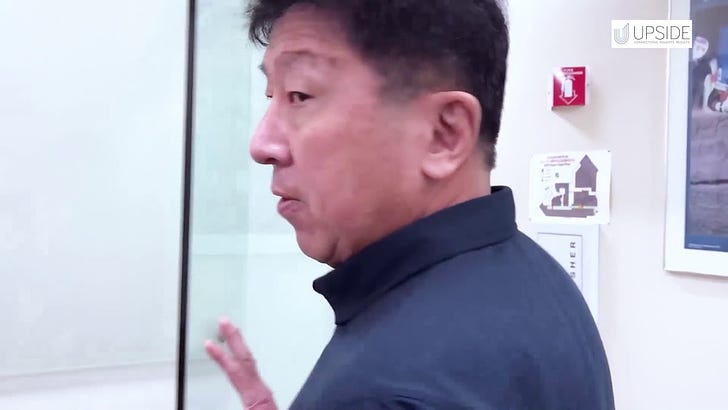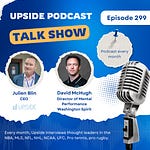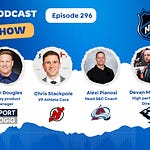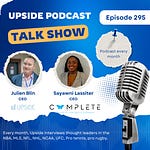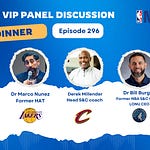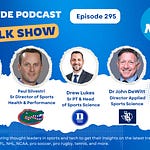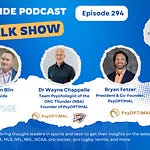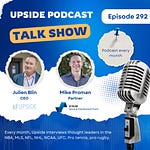Back in 2019, Dr Arthur Ting gave us a tour of his Arthur Ting orthopedic surgery and sports medicine clinic in Fremont California. Back then we spoke about technologies trends and he showed us some of the technologies (Cryotherapy, laser therapy, cooling/heating therapy, etc.) that he uses to treat his patients.
This week we had the honor to interview again Dr Arthur Ting along with Dr Ryan Ting to discuss their thoughts on injury prevention and recovery. As a reminder, Dr Arthur Ting has worked with top athletes such as Tiger Woods, Yao Ming, Regis Bush, Landon Donovan, just to name a few. Dr. Ryan Ting is an MD, MPH, and medical director at Arthur Ting orthopedic surgery and sports medicine.
📝Show Notes: Through this interview, we touched on their backgrounds, their clinic, and how they help athletes in terms of injury prevention and recovery. We also discussed the best practices to prevent injuries.
🚀Best Quotes: Here’s some of the key discussion points and best quotes from our conversation with Dr Arthur Ting and Dr Ryan Ting:
On their backgrounds:
Dr Arthur Ting:
“I'm an orthopedic surgeon. I have been in practice for over 38 years in Fremont, California with our private orthopedic clinic specializing in sports medicine. I have been involved in numerous professional teams through either associates or directly.”
“I've worked with all the pro teams (e.g. SJ Sharks/NHL, SJ Earthquakes/MLS, Warriors/NBA, SF 49ers/NFL..) in the area. I have been the team doctor, the head team physician, and the CMO for Moto GP that has been in the area. I also worked in 1984 at the Olympic Games in LA (..) Some of the better known patients that I have operated on are Tiger Woods, Joe Montana, Yao Ming, and Barry Bonds.”
Dr Ryan Ting:
“I teamed up with my father Dr Arthur Ting, who's an orthopedic sports medicine surgeon about 10 years ago. I serve as the current medical director of our functional orthopedic sports performance rehabilitation center.”
“A little bit of background about myself. I went to the University of Southern California (USC) for undergrad where I competitively played collegiate football. There I won two national championships under Pete Carroll, which I'm very proud of, and which I've learned a lot from him. I've been able to translate and transfer some of his teachings and methodologies to our practice as well.”
“In terms of my academic career, I did a two year post-baccalaureate MD program for USC and then I went on to get my medical degree. I also have a Master in Public Health. Here we take the utmost pride in proactive preventative strategies, public health, especially when it involves and addresses orthopedic injuries, especially chronic non-contact injuries.”
On the problem with the recurrence of non-contact injuries:
Dr Arthur Ting:
“We know what the mechanism of a non-contact injury is. Based on biomechanics and all the studies that have been done, it usually involves a hyperextended knee without thrust with the body weight behind the center of mass or the center of gravity behind the planted foot.”
“It's been shown thousands of times through studies that this is the most common way of a noncontact ACL. I know the mechanism of injury. The patient comes in. We get the MRI as a diagnostic tool. We do the exam, we confirm the injury, I do the surgery. The patient undergoes rehab.”
“And then the patient goes back and does the returns to the exact same environment and does it again. So how do we prevent this from happening? Now I do the surgery. I know that part, I know the mechanism of injury, but how do we specifically address the recurrence? Through the rehab, we've developed knowledge of what that patient should be doing.”
“In the early stages of rehab, everything is really done with control. We don't want the patient to run crazy legs back out on the field immediately where they can slip or recreate the injury. So during this process, we have found that there are a lot of things that are lacking in terms of retraining that athlete.”
On the things that are lacking in terms of retraining athletes after injuries:
Dr Arthur Ting:
“It's all physics, physiology, kinesiology based, and so the science is there. It's just not being coached as we we've seen. The issue is the connection between what the doctor knows and the physical therapist knows in terms of the mechanism of injury, but the coach doesn't really know what that means.”
“Like in any recovery, there's a transition. The hardest transition is from the physical therapy or the training room back to the field. In Football the coach is coaching X's and O's. They're scheming up diagrams on plays. They're not showing the athlete the proper stance that is more conducive to prevention of the ACL. Most of those things have been traditional ways, but tweaking it slightly makes a huge difference.”
On the very low margin among elite athletes between an explosive movement and a wrong movement:
Dr Arthur Ting:
“The more elite the athlete is, the less the margin there is between what I like to say, explosive movement or wrong movement and proper move. As a elite athlete, the margins are very low.”
On the reason for Odell Beckham’s recurring non-contact injury:
Dr Arthur Ting:
“Odell Beckham Jr recreated the exact mechanism of injury, non-contact, not once, but twice. And it's simply because his center of mass is behind his pace of support. Basically, his center of gravity is behind his foot.”
Dr Ryan Ting:
“Like my dad said, the margin of error for an explosive, fast twitch athlete like Odell Beckham Jr., who I love as an athlete, is very fine. But then you have an explosive athlete whose, if you make one false move, have weight distribution off slightly with that amount of explosiveness, it's a recipe for, in a high risk injury, in a high intense sport, which involves explosive change of direction.”
“If your base of support is out in front and your center of mass is behind you on an explosive movement where you're planting or cutting or decelerating, then that's a recipe for an ACL injury. You're basically over striding with your weight and with the majority of your mass behind you.”
On how to help prevent non-contact injuries by educating the athletes:
Dr Ryan Ting:
“You have to educate the athlete, and educate the patient through step wise instructions, on how to leverage body weight when you decelerate, change direction and you have impulsive impact…So you can, for chronic soft tissue injuries, but that's a different conversation. You have to address impact, control and load management.”
“I always make the following analogy. You take Arnold Schwarzenegger in his prime where he was probably the world's strongest man. And if you put him up against Muhammad Ali and you give both of them a jump rope, please believe that Muhammad Ali will have less chronic inflammations because he's more functional as an athlete.”
On the importance to emphasis functionality, dynamic movements and impact control:
Dr Ryan Ting:
“The issue that I have with a lot of athletes who come into our facility is that even though they are the prowess of body building and strength and conditioning, I'm not disregarding the prowess of that, but I will say that there has to be more emphasis on functionality, dynamic movement, and impact control.”
On the rehabilitation and training program that they have put together:
Dr Ryan Ting:
“So for us, we have a strict curriculum on biomechanics. We have a strict curriculum on educating athletes on where their weight distribution should be, where their leverage should be. It's not just postural changes. It's a slippery slope. You have to break down the technique and you have to identify the stress point when symptoms arise. In terms of traditional medicine, it's very reactive.”
“My dad and I have implemented a program that we want our athletes going through therapeutic activities through active recovery and active rest, so that they're doing controlled movement and they're learning more about adaptive mobility exercises.”
“We're creating less stress points and are being more efficient and as they heal, so they're not just sitting at home, icing, resting, and elevating because you're deconditioning the athlete's cardiovascular system. You want to still optimize an athlete's cardiovascular without shutting them down completely.”
“We try to be patient-centric. We bio-individualize and tailor a program for the individual. It's not a one size fits all. And then we're proactive and preventative about empowering athletes through this education.”
“Now we understand that we can't replicate or mimic high intensity situations, but we can put them through controlled movements where they can at least apply and transfer these tactical movements and exercises to so that they are less vulnerable in terms of maladaptive body weight stances, body maladaptive movements under stress.”
Dr Arthur Ting:
“One of the simple ways to explain it is as follow. As you know, with GPS trackers like Catapult or McLloyd, a lot of teams will monitor load management by using technologies and data.”
“What we want to do is decrease the impact. What Ryan's saying is he's showing the athletes that just in changing their movement and their body position, they can decrease impact so they can tolerate more time with less stress and less impact.”
“So instead of just keeping track of the loads, how do we get the athlete to decrease the impact and therefore decrease load and keep the capability of volume of work and reps more. So instead of just saying once he hits this milestone measuring load management we can show them how they can decrease the load by implementing better mechanics and movements and body control.”
On the comparison between Jerry Rice (49ers/NFL), Cooper Kupp (LA Rams/NFL) and Odell Beckham Jr (OBJ):
Dr Ryan Ting:
“ I'm not saying OBJ is not a technician because I love him as an athlete. I'm just saying that Jerry Rice and Cooper Kupp were known to be efficient technical route runners, who, in my opinion, have a lot of control of their bodies. So I'm not saying Odell Beckham doesn't have control. I'm saying that in more explosive, high performance athletes who are faster, that margin of error, like my dad said, is that much smaller. So in terms of control, athletes better know how to dry stick with their bodies.”
You may also like:
🔥 Upside Chat: Dave Hancock, CEO, Apollo (Leading Athlete Management Systems (AMS) vendor)🔥Upside Chat: Alexi Pianosi, Strengths and Conditioning Coach, Pittsburgh Penguins (NHL)
🔥Upside Chat: Pierre Barrieu, High Performance Director, Toronto FC (MLS)🔮 2022 Upside Top Sports Tech Predictions (NFT/Metaverse, Sports Performance, IPOs/M&As..)
🔗 🔥 Upside Analysis: NFTs Vs Crypto Vs Digital Currency, How Are They
Different?

